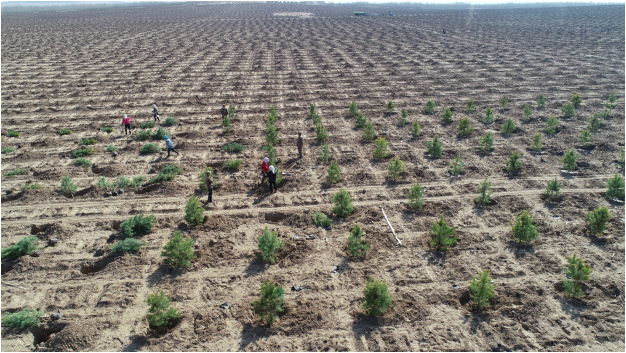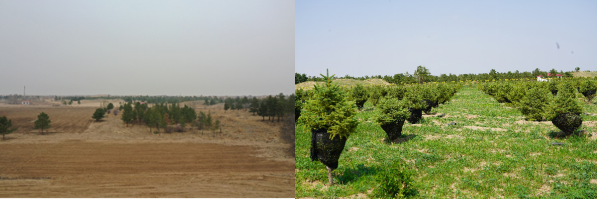
Despite the ongoing COVID-19 pandemic, APFNet continues to fight the impacts of dust storms or the ‘yellow dragon’ in Horqin Sandy Land, Inner Mongolia Autonomous Region, China. Through one of its projects in Sanyijing Forest Farm, APFNet has restored over 80 ha in the desertified grassland area and has rehabilitated about 40 ha of sandy land since January 2020. APFNet will continue to sustainably manage about 110 ha of demonstration forests established in Phase I of the project until the end of the year.
Restored sandy land with mixed species demonstration models
Although there have been other restoration initiatives in the area, these have mainly used single species (which have not always been well-adapted to local conditions) to restore sandy land, meaning lower levels of ecosystem functionality. Through the newly developed mixed species restoration models, APFNet aims to not only fight desertification, but also to establish more natural forests instead of using monocultures.
Restoration Model I: Mixed coniferous and broadleaf species were planted on 55.67 ha of semi-arid land, all in square plots with one species acting as a shelterbelt and the other to fix sand within the plot.

Planting lines of Mongolian pine in squares serving as a shelterbelt (April 2020).Photo: Forestry and Grassland Administration of Aohan Banner

Before (left) and after(right): The planting of 55.67 ha of mixed coniferous and broadleaf trees on semi-arid land.Photos: Forestry and Grassland Administration of Aohan Banner
This restoration model has three sub-models:
Sub-model 1: A combination of Mongolian pine and winged euonymus (Euonymus alatus) in a square plot. Mongolian pine is planted outside as a shelterbelt (wind-break) and euonymus inside to fix sand. Nets and sheets are used as well.
Sub-model 2: A combination of Mongolian pine and David’s peach (Prunus davidiana) in a square plot. Planting and functions are the same as sub-model 1, assisted by the use of nets and sheets.
Sub-model 3: A combination of Mongolian pine and purpleblow maple (Acer truncatum) in a square plot. Planting and functions are the same as sub-model 1, assisted by the use of nets and sheets.
Restoration Model II: A combination of Mongolian pine (Pinus sylvestris var. mongolica) and Siberian elm (Ulmus pumila) planted on 6.67 ha of sandy land. Specifically, the model aims to act as a shelterbelt, where six rows of Mongolian pine are followed by four rows of Siberian elm, totalling 4 ha of Mongolian pine and 2.67 ha of Siberian elm. This planting pattern forms a wind-break and effectively fixes sand and dunes.

Before (left) and after (right): Planting of Mongolian pine combined with Siberian elm. Photos: Forestry and Grassland Administration of Aohan Banner
Restoration Model III: A combination of 10 ha of Mongolian pine and Siberian elm was planted along the sand-passing road, which is the main operation road of the forest farm. Similar to the previous models the planting was once again arranged as a shelterbelt, with four rows of Mongolian pine (totalling 6.67 ha) and two rows of Siberian elm (totalling 3.33 ha) to form a wind-break and fix sand respectively.

Before (left) and after (right): Planting of Mongolian pine combined with Siberian elmPhotos: Forestry and Grassland Administration of Aohan Banner
Restoration Model IV:Establishment of a demonstration garden, featuring about 40 common tree and shrub species, including 5 evergreen species, 7 sandy tree species,6 greening species, 5 poplar species, 7 greening species and 9 sandy shrub species.

Before establishment of the demonstration garden (left) and after (right).Photos: Sanyijing Forest Farm
Further rehabilitation of degraded forests with mixed models
Owing to the afforestation efforts of the past, there are now 4,202 ha of pure poplar forests in Sanyijing Forest Farm. Most are fairly degraded, consisting mostly of small old trees with severe forms of die-back. Field investigation revealed that damage and die-back of the forest stands mostly appeared in clusters covering large areas, with several gaps.
In Phase II of the project, to avoid logging of the existing trees, different tree species were planted underneath the dominant species to enrich the overall species mixture. Species were chosen for their resistance to drought and cold as well as wind-break, soil conservation and sand fixation capacities in arid and semi-arid desertified areas. Overall, three different models showcase how these stands have been rehabilitated:
Rehabilitation Model I: Fourteen hectares of demonstration conversion forests were planted in shelterbelt formation using Chinese red pine (Pinus tabuliformis) and yellowhorn (Xanthoceras sorbifolium); 7 ha were new afforestations and 7 ha were old plantations kept for comparison.
Rehabilitation Model II: Fourteen hectares of demonstration conversion forests with enrichment planting in shelterbelts, using Mongolian pine and David’s peach; 7 ha of newly afforested area and 7 ha of old plantations kept for comparison.
Rehabilitation Model III: Twelve hectares of demonstration conversion forest arranged in a square plot, using dragon spruce (Picea asperata) and Siberian elm; 7 ha of newly afforested area and over 5 ha of old plantations kept for comparison.
During Phase II, efforts to further tend, manage and monitor about 110 ha of demonstration forest (30 ha of pure restoration forest, 79 ha of economic forest) established in Phase I, will continue.
At the start of January 2020, APFNet continued support for the second phase of the anti-desertification project in Horqin Sandy Land, which will be ongoing for another three years. The project is being implemented by Sanyijing State-owned Forest Farm, Aohan Banner, Chifeng City of Inner Mongolia Autonomous Region, and is supervised by the Forestry and Grassland Administration of Chifeng City. The total project budget is approximately USD 1,471,000 of which USD 1,160,000 is provided by APFNet.